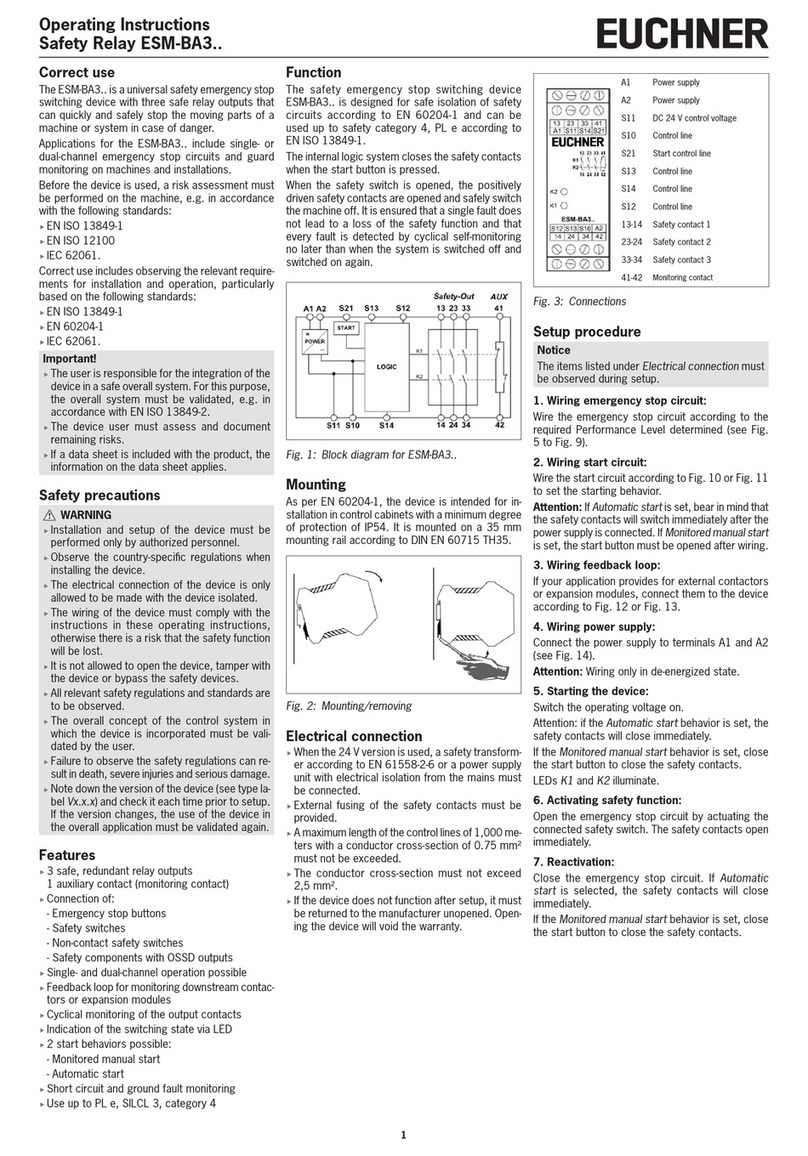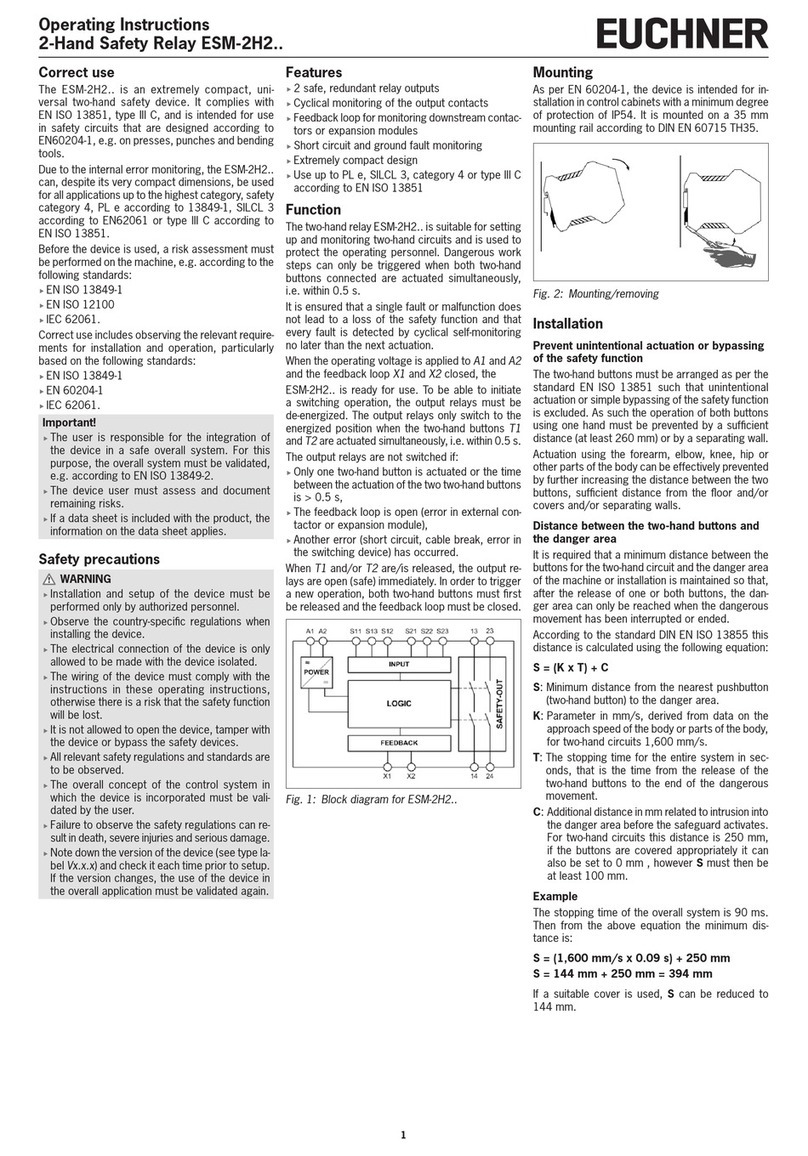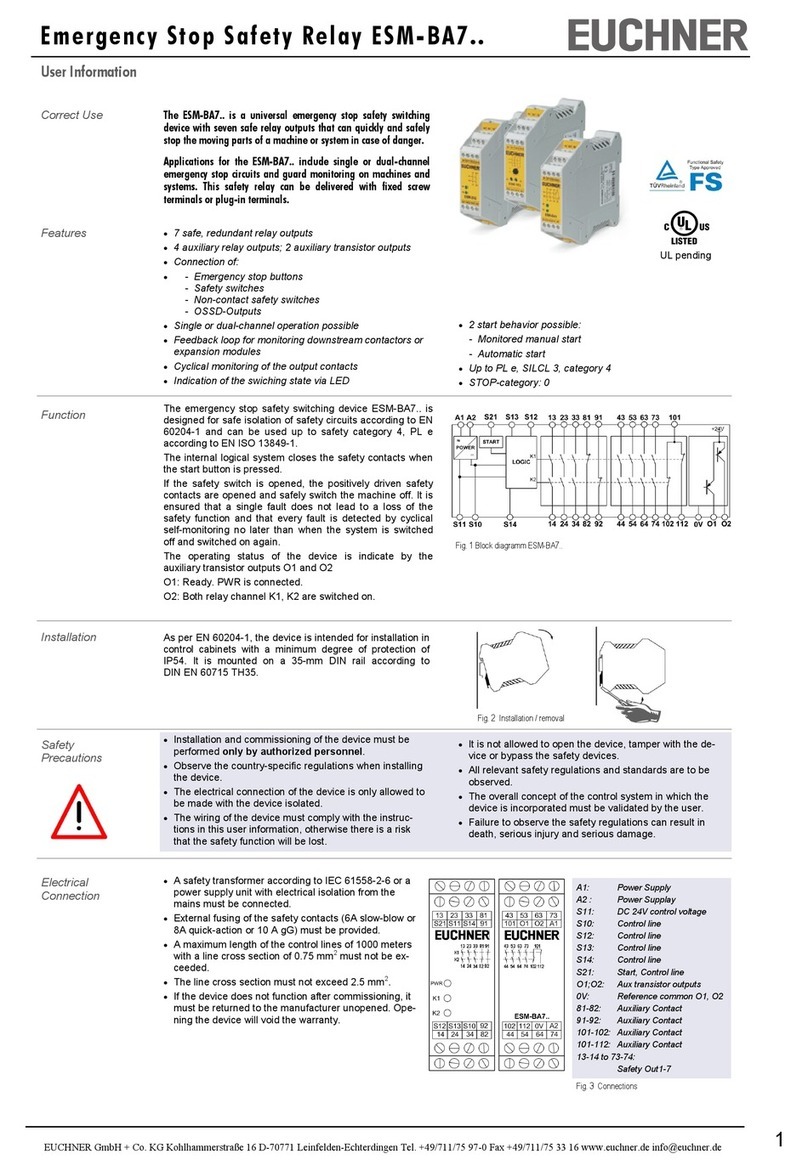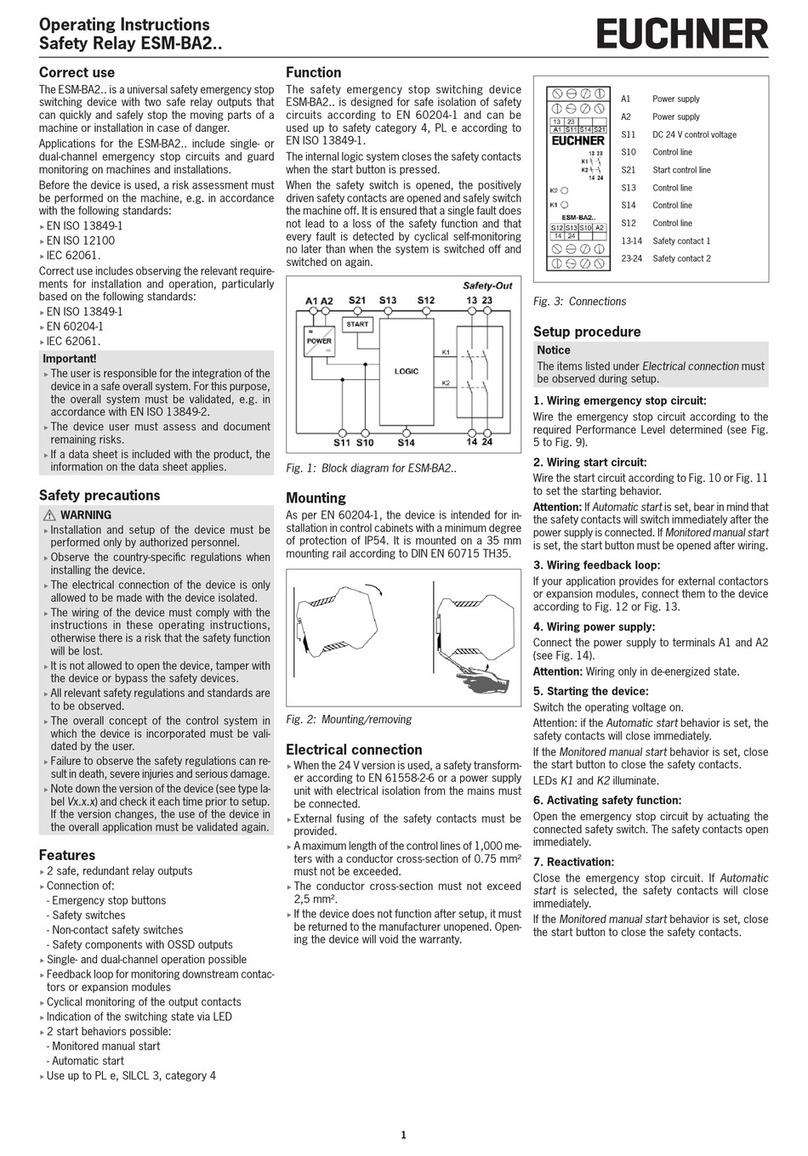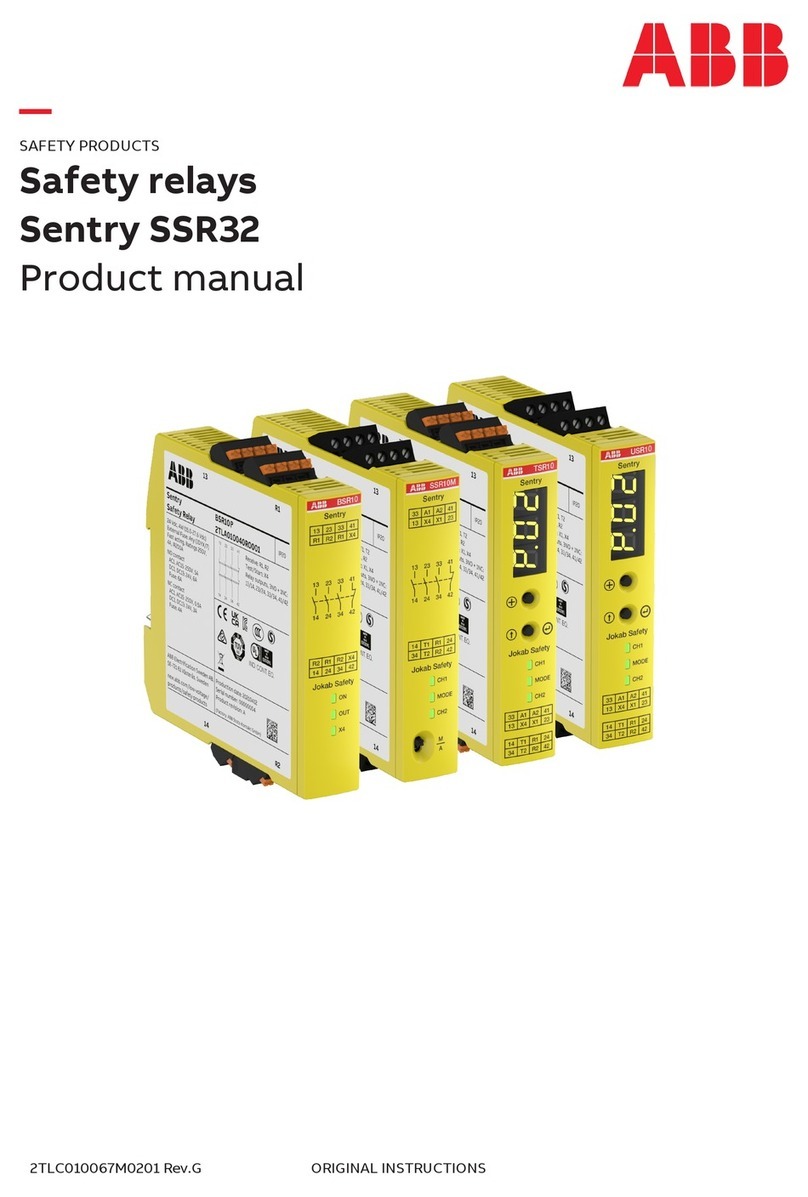
1
Operating Instructions
Safety Relay ESM-BT4..
Correct use
ESM-BT4.. is an emergency stop safety relay com-
bination that combines non-time-delayed (u) and
time-delayed (v) contacts in a very compact housing.
This permits dangerous components of a system to
be switched off quickly and safely in an emergency
situation. At the same time, other safety circuits
can continue to be supplied with power for up to
30 seconds to allow a tool to be moved to its idle
position or to brake overtraveling parts, for example.
Before the device is used, a risk assessment must
be performed on the machine, e.g. according to the
following standards:
fENISO13849-1
fENISO12100
fIEC62061.
Correct use includes observing the relevant require-
ments for installation and operation, particularly
based on the following standards:
fENISO13849-1
fEN60204-1
fIEC62061.
Important!
fThe user is responsible for the integration of
the device in a safe overall system. For this
purpose, the overall system must be validated,
e.g. according to ENISO13849-2.
fThe device user must assess and document
remaining risks.
fIf a data sheet is included with the product, the
information on the data sheet applies.
Safety precautions
WARNING
fInstallation and setup of the device must be
performed only by authorized personnel.
fObserve the country-specic regulations when
installing the device.
fThe electrical connection of the device is only
allowed to be made with the device isolated.
fThe wiring of the device must comply with the
instructions in these operating instructions,
otherwise there is a risk that the safety function
will be lost.
fIt is not allowed to open the device, tamper with
the device or bypass the safety devices.
fAll relevant safety regulations and standards are
to be observed.
fThe overall concept of the control system in
which the device is incorporated must be vali-
dated by the user.
fFailure to observe the safety regulations can re-
sult in death, severe injuries and serious damage.
fNote down the version of the device (see type la-
bel Vx.x.x) and check it each time prior to setup.
If the version changes, the use of the device in
the overall application must be validated again.
Features
f4 safe, redundant relay outputs. Depending on
variant:
- 3 non-time-delayed contacts, 1 time-delayed
contact
- 2 non-time-delayed contacts, 2 time-delayed
contacts
- 1 non-time-delayed contact, 3 time-delayed
contacts
fContinuously adjustable delay time (1 … 30 s)
or fixed delay time (ESM-BT4..-20S (2 s);
ESM-BT4..-50S (5s))
fConnection of:
- Emergency stop buttons
- Safety switches
- Non-contact safety switches
- Safety components with OSSD outputs
fSingle- and dual-channel operation possible
fFeedback loop for monitoring downstream contac-
tors or expansion modules
fCyclical monitoring of the output contacts
fIndication of the switching state via LED
f2 starting behaviors possible:
- Monitored manual start
- Automatic start
fShort circuit and ground fault monitoring
fUse up to PLe, SILCL3, category4
Function
The moving parts of a machine or system can be
quickly and safely stopped in case of danger with the
non-time-delayed contacts of the ESM-BT4... Safety
contacts with time-delay switch-off are also integrat-
ed into the ESM-BT4... They are used whenever it is
safer to keep supplying power to parts of a machine
after the emergency stop button is actuated.
It is ensured that a single fault or malfunction does
not lead to a loss of the safety function and that
every fault is detected by cyclical self-monitoring
no later than when the system is switched off and
switched on again.
The time-delayed contacts switch on at the same
time as the non-time-delayed contacts, but they are
switched off again only after the time set on the
potentiometer elapses (1…30s) or after a xed
delay time (ESM-BT4..-20S; ESM-BT4..-50S) when
the emergency stop button is operated.
The power supply must be present during the time
sequence.
ESM-BT401 (1 non-time-delayed/3 time-delayed)
ESM-BT411 (2 non-time-delayed/2 time-delayed);
ESM-BT421 (3 non-time-delayed/1 time-delayed)
Fig. 1: Block diagrams ESM-BT4..
Mounting
As per EN60204-1, the device is intended for in-
stallation in control cabinets with a minimum degree
of protection of IP54. It is mounted on a 35 mm
mounting rail according to DINEN60715TH35.
Fig. 2: Mounting/removing
Electrical connection
fA safety transformer according to EN61558-2-6
or
a power supply unit with electrical isolation from
the mains must be connected.
fExternal fusing of the safety contacts must be
provided.
fA maximum length of the control lines of 1,000 m
with a conductor cross-section of 0.75mm² must
not be exceeded.
fThe conductor cross-section must not exceed
2.5mm².
fIf the device does not function after setup, it must
be returned to the manufacturer unopened. Open-
ing the device will void the warranty.
A1 Power supply
A2 Power supply
S11 DC24V control voltage
S10 Control line
S21 Start control line
S13 Control line
S14 Control line
S12 Control line
13-14 Safety contact 1 (u)
23-24 /
27-28 Safety contact 2 (u / v)
33-34 /
37-38 Safety contact 3 (u / v)
47-48 Safety contact 4 (v)
Fig. 3: Connections
(u=non-time-delayed, v=time-delayed)
Setup procedure
Notice
The items listed under Electrical connection must
be observed during setup.
1. Wiring emergency stop circuit:
Wire the emergency stop circuit according to the
required Performance Level determined (see Fig.
5 to Fig. 9).
2. Wiring start circuit:
Wire the start circuit according to Fig. 10 or Fig. 11
to set the starting behavior.
Attention: If Automatic start is set, bear in mind that
the safety contacts will switch immediately after the
power supply is connected. If Monitored manual start
is set, the start button must be opened after wiring.
3. Wiring feedback loop:
If your application provides for external contactors
or expansion modules, connect them to the device
according to Fig. 12 or Fig. 13.
